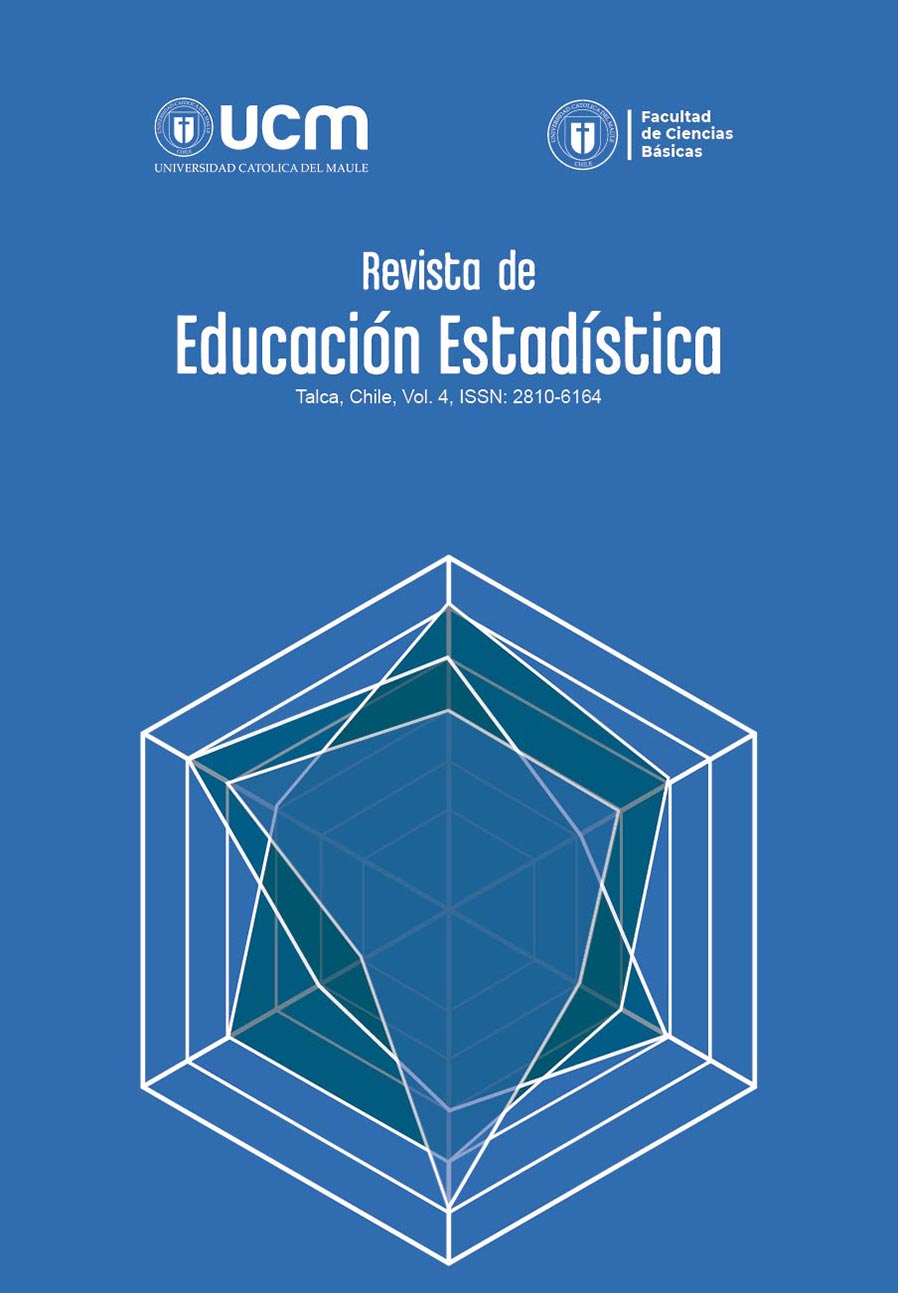La formulación y argumentación de conjeturas en contextos de incertidumbre por estudiantes de secundaria (12-16) Retos para la enseñanza
Contenido principal del artículo
Resumen
Detalles del artículo
Astawa, I.W.P., Budayasa, I.K. y Juniati, D. (2018). The Process of Student Cognition in Constructing Mathematical Conjecture. Journal on Mathematics Education, 9(1), 15-26. https://doi.org/10.22342/jme.9.1.4278.15-26
Banting, N., Vashchyshyn, L. y Chernoff, E. J. (2018). In No Uncertain Terms: Encouraging a Critical Stance Toward Probability in School. En A. Kajander, J. Holm y E. Chernoff (Eds.), Teaching and Learning Secondary School Mathematics, Advances in Mathematics Education (pp. 571-588). Springer. https://doi.org/10.1007/978-3-319-92390-1_53
Batanero, C. y Borovnick, M. (2016). Statistics and Probability in High School. Sense Publishers.
Benson, C.T. y Jones, G.A. (1999). Assessing Students’ Thinking in Modeling Probability Contexts. The Mathematics Educator, 4(2), 1-21.
Borovcnik, M. y Kapadia, R. (2018). Reasoning with Risk: Teaching Probability and Risk as Twin Concepts. En C. Batanero y E. Chernoff (Eds.), Teaching and Learning Stochastics. ICME-13 Monographs. Springer. https://doi.org/10.1007/978-3-319-72871-1_1
Cañadas, M.C., Deulofeu, J., Figueiras, L., Reid, D. y Yevdokimov, O. (2007). The conjecturing process: perspectives in theory and implication in practice. Journal of Teaching and Learning, 5(1), 55-72. https://doi.org//10.22329/JTL.V5I1.82
Chaput, B., Girard, J.C. y Henry, M. (2011). Frequentist approach: Modelling and Simulation in Statistics and Probability Teaching. En C. Batanero, G. Burril y C. Reading (Eds.), Teaching Statistics in School Mathematics- Challenge for Teaching and Teachers Education: A Joint ICMI / IASE Study (pp. 85-95). Springer.
Ciccolini, G. y Stylianides, G.J. (2020). Teaching to listen, question, and ponder: An investigation into promoting an enquiring atmosphere in a mathematics classroom. Journal of Educational Research in Mathematics, 30(SP1), 29-68. https://doi.org/10.29275/jerm.2020.08.sp.1.29
Cobb, P. y McClain, K. (2004). Principles of instructional design for supporting the development of students’ statistical reasoning. En D.Ben-Zvi y J.Garfield (Eds.), The Challenge of Develeoping Satstistical Literacy, Resoning and Thinking (pp. 375-395). Springer.
De Villiers, M. y Heideman, N. (2014). Conjecturing, Refuting and Proving within the Context of Dynamic Geometry. Learning and Teaching Mathematics, 17, 20-26.
Fatmanissa, N., Yuli Eko Siswono, T., Lukito, A. e Ismail, I. (2024). Utilizing decision-making task: students’ mathematical justification in collaborative problem solving. Avances de investigación en Educación Matemática, 26, 85-103. https://doi.org/10.35763/aiem26.5341
Fiallo, J. y Gutiérrez, A. (2017). Analysis of the cognitive unity or rupture between conjecture and proof when learning to prove on a grade 10 trigonometry course. Educational Studies in Mathematics 92(2), 145-167.
Gavilán-Izquierdo, J.M. y Fernández-León, A. (2023). Caracterizando cómo conjeturan los investigadores en matemáticas: un estudio de caso. Avances de Investigación en Educación Matemática, 24, 21-37. https://doi.org/10.35763/aiem24.4223
Huerta, M.P. (2002). El problema de la cueva. Elementos para un análisis didáctico de los problemas de probabilidad. Enseñanza de las Ciencias, 20(1), 75-86. https://doi.org/10.5565/rev/ensciencias.3980
Huerta, M.P. (2018). Preparing Teachers for teaching probability through problem solving. En C. Batanero y E.J. Chernif (Eds.), Teaching and Learning Stochastics, ICME-13 Monographs (pp. 293-311). Springer. https://doi.org/10.1007/978-3-319-72871-1_17Huerta, M.P. (2020). Hipótesis y conjeturas en el desarrollo del pensamiento estocástico: retos para su enseñanza y en la formación de profesores. Revista Latinoamericana de Investigación en Matemática Educativa, 23(1), 79-102. https://doi.org/10.12802/relime.20.2313b
Lakatos, I. (1976). Proofs and Refutations. Cambridge Academic Press.
Liu, S. y Ho, F. (2008). Conjecture activities for comprehending statistics terms through speculations on the functions of imaginary spectrometers. AMT, 64(3), 17-24.
Makar, K. y Rubin, A. (2018). Learning about statistical inference. En D. Ben-Zvi, K. Makar y J. Garfield (Eds.), International Handbook of Research in Statistics Education (pp. 261-294). Springer.
Martín, R. (4 de julio de 2022). Las competencias y los sentidos matemáticos en el nuevo currículo. [Comunicación en congreso]. Escuela de Educación Matemática Miguel de Guzmán, Santander.
Ministerio de Educación y Formación Profesional (2022). Real Decreto 217/2022, de 29 de marzo, por el que se establece la ordenación y las enseñanzas mínimas de la Educación Secundaria Obligatoria. Ministerio de Educación y Formación Profesional.
Minyana, M. y Huerta, M.P. (2022). Introducir y desarrollar el sentido estocástico mediante la resolución de problemas. En FESPM (Ed.), Libro de Actas JAEM 20. Matemáticas para construir el mundo (pp. 328-352). FESPM.
Moore, D. S. (1990). Uncertainty. En L.A. Steen (Ed.), On the Shoulders of Giants: New approaches to Numeracy (pp. 95-137). National Academy Press.
Polya, G. (1966). Matemáticas y razonamiento plausible. Tecnos.
Pratt, D. (2011). Re-connecting probability and reasoning about data in secondary school teaching. En International Statistical Institute (Ed.), Proceedings of the 58th World Statistical Congress (pp. 890-899). ISI.
Rabbani, S. y Herman, T. (2017). Increasing formulate and test conjecture math competence and self confidence in using the discovery learning teaching math. Journal of Primary Education, 1(1), 119-128. https://doi.org/10.22460/pej.v1i1.488
Real Academia Española. (s.f). Conjetura. En Diccionario de la lengua española. Recuperado en 15 de enero de 2025, de https://dle.rae.es
Rossman, A. (2008). Reasoning about informal statistical inference: One statistician’s view. Statistic Education Research Journal, 1(1), 119-128. https://doi.org/10.52041/serj.v7i2.467
Ruiz-Reyes, K. y Contreras, J.M. (2021) Comprensión del muestreo por estudiantes chilenos de educación secundaria. Statistics Education Research Journal, 20(2), 11. https://doi.org/10.52041/serj.v20i2
Sociedad Española de Investigación en Educación Matemática (s.f.). Página principal. https://www.seiem.es
Shaughnessy, J.M. (1983). The psychology of inference and the teaching of probability and statistics: Two sides of the same coin? En R.W. Sholz (Ed.), Decision making under uncertainty (pp. 325-350). Elsevier.
Viñas, J. M., Burguete, B., López, M. y Santos, C. (2018). Probabilidad e incertidumbre en la sociedad y en los medios. En C. Santos (Ed.), Física del caos en la predicción meteorológica (pp. 615-626). Agencia Estatal de Meteorología.
Watson, J. y Moritz, J. (2000). Developing Concepts of Sampling. Journal for Research in Mathematics Education, 31, 44-70. https://doi.org/10.2307/749819
Watson, J. y Smith, C. (2022). Statistics education at a time of global disruption and crises: a growing challenge for the curriculum, classroom and beyond. Curriculum Perspectives, 42, 171-179. https://doi.org/10.1007/s41297-022-00167-7Zimmermann, G. (2002). Students’ reasoning about probability simulation during instruction. [Tesis Doctoral, Illinois State University].

Este obra está bajo una licencia de Creative Commons Reconocimiento-NoComercial-CompartirIgual 4.0 Internacional.


